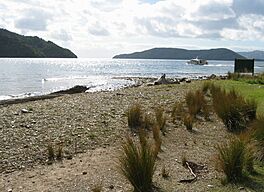Meretoto / Ship Cove facts for kids
Quick facts for kids Meretoto / Ship Cove |
|
|---|---|

View across the sound to Motuara Island from Ship Cove in 2004
|
|
| Location | Marlborough Sounds |
| Coordinates | 41°05′35″S 174°14′20″E / 41.09306°S 174.23889°E |
| Etymology | Named for the location where James Cook anchored his ship. 'Meretoto' has unclear origins |
Meretoto / Ship Cove is a small bay in the Marlborough Region of New Zealand. It is famous as the first place where Māori people and Europeans had long-lasting contact. The bay is located near the entrance of Queen Charlotte Sound / Tōtaranui, close to Motuara Island and Long Island.
Explorer James Cook anchored his ships here many times. Because of this, he named it Ship Cove. In 2014, the official name was changed to "Meretoto / Ship Cove". This change added its original Māori name. The meaning of the name Meretoto is not fully known.
About 1,700 acres (6.9 km²) of land at the cove is a special scenic reserve. This means it is protected for its natural beauty. The Department of Conservation (New Zealand) now looks after this important historic place.
Who were the first visitors to Meretoto?
People believe that the great Polynesian explorer, Kupe, was the first person to visit Tōtaranui. Many places in the area are named after Kupe.
The entrance to the sound was an important stopping point. It was used by Māori traveling between Te Ika-a-Māui / the North Island and Te Waipounamu / the South Island. The cove was a safe place to rest before or after crossing the strait.
In the late 1770s, people did not live at the cove all year round. They came during the summer to fish and gather seasonal foods.
James Cook's visits to the bay
On January 15, 1770, Captain Cook brought his ship, HMS Endeavour, into the cove. He used it as a base to get more food, water, and wood after his long journey across the Pacific Ocean.
While his ship was being repaired, Cook set up a base on the shore. He ordered his crew to plant vegetable gardens and build a pen for pigs. Cook returned to the cove five more times during his first, second, and third trips to the Pacific. In other parts of New Zealand, contact with Europeans was short. But here, it lasted for a longer time.
What happened after Cook's visits?
When Cook's first voyage was written about, Ship Cove became famous around the world. This attracted whalers and other explorers to the area. By 1810, whalers were already visiting the cove.
People from Anaho, a bay just north of Ship Cove, had close contact with the whalers. They helped the visitors. Later, some Māori people became Christians and learned to read and write.
In May 1820, two Russian ships, Vostok and Mirny, sailed into the bay. They were led by Fabien von Bellingshausen. They used a map based on one Cook made. The ships anchored near Motuara Island, where Cook's ship HMS Resolution (1771) (Resolution) had anchored earlier.
Bellingshausen and his men had careful but friendly meetings with the local Māori. They traded items like knives and axes for fish and interesting objects. Many of these objects are now in museums in St Petersburg and Kazan.
Colonel William Wakefield, who helped start Wellington, also anchored his ship Tory in the cove in 1839. Māori chiefs from the area signed the Treaty of Waitangi here on May 4, May 5, and June 17, 1840.


